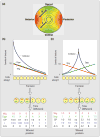Limb morphogenesis: connections between patterning and growth
- PMID: 9162486
- PMCID: PMC2749718
- DOI: 10.1016/s0960-9822(97)70085-x
Limb morphogenesis: connections between patterning and growth
Abstract
Limb development is a complex process involving precise control of both patterning and growth. Great strides have been made in understanding limb morphogenesis and identifying essential patterning genes in Drosophila. Differential expression of these genes divides the future limb into territories, which will give rise to different regions of the adult appendage. Recent analyses have defined the role of territorial boundaries as organizers of both patterning and growth, highlighting the connection between these two processes. The organizing activity of territorial boundaries seems to be mediated through the activity of two locally produced morphogens: Wingless and Decapentaplegic. We propose a model in which these two molecules, distributed in a graded fashion, act in synergy to promote growth of the entire appendage. We also suggest that existence of growth inhibitors that counteract the action of Wingless and Decapentaplegic; by opposing the gradient of these growth factors, the inhibitors guide the near-uniform proliferation that shapes the imaginal discs from which the adult appendages are formed in Drosophila.
Figures





References
-
- Spemann H, Mangold H. Uber induktion von embryonenanlagen durch implantation artfremder organisatoren. Arch Mikrosk Anat Entw Mech. 1924;100:599–638.
-
- Tickle C, Summerbell D, Wolpert L. Positional signalling and specification of digits in chick limb morphogenesis. Nature. 1975;254:199–202. - PubMed
-
- Cohen SM. Imaginal disc development. In: Bate M, Martinez-Arias A, editors. The Development of Drosophila melanogaster. Plainview, New York: Cold Spring Harbor Laboratory Press; 1993. pp. 747–841.
-
- Cohen B, Simcox AA, Cohen SM. Allocation of the thoracic imaginal primordia in the Drosophila embryo. Development. 1993;117:597–608. - PubMed
-
- Garcia-Bellido A. Cell Patterning CIBA symposium. Boston: Little Brown; 1975. Genetic control of wing disc development in Drosophila; pp. 161–183. - PubMed
Publication types
MeSH terms
Substances
Grants and funding
LinkOut - more resources
Full Text Sources
Molecular Biology Databases

